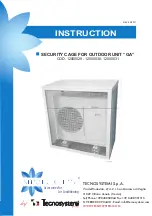
22
ECU 12/2014 NEW
PROBLEM/SYMPTOM
LIKELY CAUSE(S)
CORRECTION
C. Unit cycles on high/low pressure
limit.
1. Loss or restriction of airflow.
2. Restriction in refrigerant circuit.
3. Refrigerant overcharge (following
field service)
4. Defective pressure control.
1. Check blower assembly for proper operation. Look
for airflow restrictions, e.g.. the air filter. Check blower
motor and condenser fan.
2. Check for blockage or restriction, especially filter drier
and capillary tube assembly.
3. Evacuate and recharge to factory specifications.
4. Check limit cutout pressures. Control is set to actuate at
approximately 60 PSIG (low pressure) and 650 PSIG (high
pressure).
D. Unit blows fuses or trips circuit
breaker.
1. Inadequate circuit ampacity.
2. Short, loose, or improper connection
in field wiring.
3. Internal short circuit. Loose or
improper connection(s) in unit.
4. Excessively high or low supply volt-
age or phase loss (3ø only).
1. Note electrical requirements in Chapter 2 and correct
as necessary.
2. Check field wiring for errors.
3. Check wiring in unit. See wiring and schematic dia-
grams. Test components (especially the compressor)
for shorts.
4. Note voltage range limitations specific to the com-
pressor troubleshooting section.
E. Water on floor near unit.
1. Obstruction in condensate line.
2. Obstruction or leak in condensate
pan.
3. Unit is not level.
1. Check for clog or restriction.
2. Check pan for leak or blockage.
3. Level unit.
F. No space heating or reduced heating
(units equipped with resistance ele-
ments)
1. Defective heating element(s).
2. Thermal limit open.
3. Defective heater contactor.
1. Check resistance element(s) for continuity.
2. Check continuity across thermal limit switch.
3. Check relay for proper operation. Replace if defective.
4.3 Compressor
Troubleshooting
NOTE: It is important to rule out other component failures before condemning the compressor.
The following electrical tests will aid diagnosis:
1.
Start-Up Voltage
: Measure the voltage at the compressor contactor during start-up. The voltage
must exceed the minimum shown in Table 5, section 2.2, or compressor failure is likely. A low
voltage condition must be corrected.
2.
Running Amperage
: Connect a clip-on type ammeter to the (common) lead to the compressor.
Turn on the supply voltage and energize the unit. The compressor will initially draw high amperage;
it should soon drop to the RLA value or less. If the amperage stays high, check the motor winding
resistances.
NOTE:
Feel the top of the compressor to see if it has overheated. If it is hot, the internal overload
may be open. You may have to wait several hours for it to reset.





































